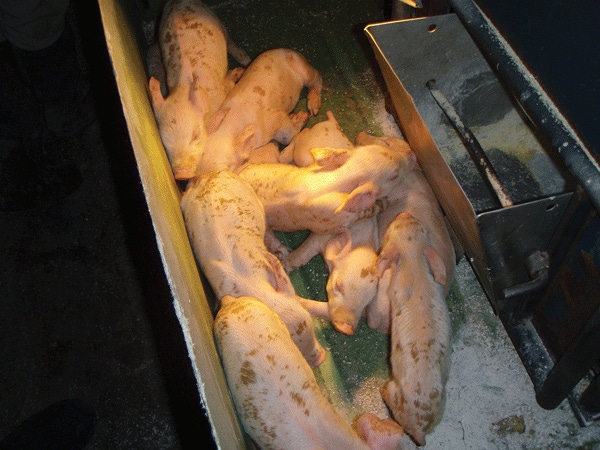Swine veterinarians and diagnosticians explain what is known and not known about the virus new to U.S. herds.
July 15, 2013

The introduction of porcine epidemic diarrhea (PED) virus into the United States this spring has raised more questions than researchers and veterinarians have answers.
Early on, all signs of the disease pointed to transmissible gastroenteritis (TGE), a well-known, highly contagious viral disease characterized by vomiting, severe diarrhea and often 100% mortality of piglets less than 2 weeks of age. “TGE storms” known to produce large bunches of aborted, stunted and mummified piglets in farrowing are familiar to veteran pork producers and veterinarians.
But this virus is different. While intestinal tissues from very young pigs showed severe lesions consistent with TGE, all laboratory tests came back negative to the TGE virus. That sent diagnosticians back to the laboratory to double-check their test for TGE. When the test proved effective for TGE, it confirmed their fears — they are dealing with a new virus.

Greg Stevenson, DVM
“Interestingly, results were negative on tests that detected nucleic acid from the TGE virus, as well as detecting proteins from the virus using antibodies,” explained Greg Stevenson, DVM, director of the Iowa Veterinary Diagnostic Laboratory (IDVL), to a packed crowd attending a special luncheon during World Pork Expo in June.
Diagnosticians turned to their electron microscopes to study the type of viruses present in fecal samples. “What we saw was viral particles more consistent with coronavirus — the virus family that the TGE virus is a part of,” he continued. “Knowing that it was a coronavirus, and knowing that none of our tests cross-reacted with it made us suspect it was PED virus, a well-known virus around the world, particularly in Europe and southeastern Asia.”
The next step was to compare the gene sequence to those deposited in an open-access, annotated global database, GenBank.
“The PED virus sequence matched above 99% with a GenBank deposit from China; at that point, we had the virus identified,” Stevenson said.
As a backstop, IDVL technicians sent samples to the National Veterinary Services Laboratory (NVSL) in Ames, IA, which serves as a reference laboratory for all of the state diagnostic laboratories.
NVSL, too, has the capability to sequence the genes in the samples, and later sequenced the entire PED virus genome. “The complete virus genome sequence was 99.1% to 99.6% homologous with 2012 deposits of two different viruses from China. So, we know the virus is from southeastern Asian linage, but that doesn’t mean that recent outbreaks came directly from China. It just means that’s where it was originally identified,” Stevenson reinforced.
PED Virus Central
As diagnostic efforts at IVDL were ramped up, laboratories at the University of Minnesota, South Dakota State University and Kansas State University joined the national effort to track PED virus cases.
In a cooperative effort, those state laboratories began submitting test results to the Iowa State team to get a more accurate picture of how PED virus was spreading. However, given how the U.S. pork industry is structured, it is important to remember that the number of recorded cases does not necessarily reflect how widespread the disease is, because the count is limited to cases solely submitted and confirmed by diagnostic laboratories. Samples reflect the state where the submitting veterinarian is located and/or the address of the owner of the pigs, but not necessarily the location of the sampled pigs, Stevenson noted.
Additionally, IVDL had been storing fecal samples from previous diarrhea cases, which allowed technicians to go back to the date of the initial diagnosis (May 29) and work back through fecal samples in which TGE diagnostics had been requested. The goal was to possibly identify herds that might have broken with PED virus earlier.

Lisa Becton, DVM
Many of the PED virus outbreaks occurred in a very short period of time (April-May) across a wide range of states, on unrelated farms. This has puzzled producers with infected herds, who are asking experts to ferret out the possible routes of transmission, explained Lisa Becton, DVM, director of swine health at the National Pork Board. Of concern is the potential for the virus to be spread via feed. Testing is ongoing.
Effective Sampling
IVDL’s Stevenson urged producers to work with their veterinarians to get good samples for laboratory analysis. “The samples we least like to see are fecal samples where people want to survey whether the site is positive for PED virus. If they see diarrhea, they wonder if it is ‘that’ virus, so they go around and grab poop samples off the floor and pool them,” he notes.
Ineffective sampling wastes valuable laboratory time and effort and generally doesn’t yield worthwhile results, he emphasized.
“If you have a site that you suspect is breaking with PED virus, we prefer that you euthanize acutely infected animals, collect multiple segments of the small and large intestines and quickly place them in a fixative. That allows us to determine if they have lesions consistent with this disease,” he continued.
“Next, we utilize the polymerase chain reaction [PCR] test to verify whether the virus is present. And, we have an immuno-histochemistry test that allows us to identify the virus using antibodies in a tissue section, which is a completely different test and technology from the genetic test. This allows us to use three different criteria — the presence of lesions, the presence of viral antigen in the tissue associated with the lesion, and the positive PCR test — to confirm PED virus infection. Then, we’re really, really sure of the diagnosis,” he added.
Additional guidelines for effective sampling are available at vetmed.iastate.edu/vdpam/disease-topics/porcine-epidemic-diarrhea-ped-diagnostic-testing.
Viral Family Affair
“PED virus is a coronavirus in the same virus group as TGE, but it is not the same as TGE,” Becton clarified. Both are RNA viruses, important because RNA viruses are known to mutate.
PED virus is not new. It’s been found in many parts of the world, and is considered endemic to Europe and Asia. It is not a zoonotic disease —transferable from pigs to people. The disease only affects pigs, so it is not a food safety risk, she reassured. Nor is PED virus a reportable disease in the United States. Therefore, no trade restrictions exist intrastate (within) or interstate (between) states.

Joe Connor, DVM
Field Experiences
In early cases, death loss was thought to be caused by TGE, reinforced Joe Connor, DVM, Carthage (IL) Veterinary Service. “The chronology of events made it look much like TGE. At Day 2 [after birth], pigs already had some diarrhea. On Day 3, there was severe dehydration and emaciation. On Days 4-5, we saw quite high rates of mortality,” he said.
Gross lesions were also similar to TGE in breed-to-wean and wean-to-finish production systems. Intestines were extended and contained yellow fluid throughout, indicating that intestinal villi had been eroded, he reported.
In some early cases, excess inflammation or redness in the intestinal tract made it appear the infections might be very acute cases of E. coli. As it turned out, they were infections of PED virus, Connor explained.
“The disease is very devastating in the farrowing house. A lot of the losses are due to dehydration. This virus, just like TGE, will attack the cells that line the intestine and the gut, and doesn’t allow the pig to absorb any nutrients, resulting in high death loss,” Becton explained.
“If weaned pigs get infected, they are going to be more severely affected than 180-lb. pigs,” Connor said. Bouts of diarrhea may last 48-72 hours. Infected finishing hogs may or may not go off feed.
Infected sows show signs typical to a TGE infection, with sows going off feed for a day or two. There will be a “cow pie” type of diarrhea behind the sows, he added.
Controlling the Virus
“The control program we put in place has been a very aggressive feedback that has been used in our TGE elimination programs,” Connor explained. “In those programs, we get every sow on the farm exposed naturally to the virus, through feedback of fecal material or through feedback of intestinal content of the pigs with diarrhea.”
Replacement gilts receive feedback for 90 days prior to introduction into the breeding herd.
For feedback of intestinal content, collect material from scouring pigs, mix with water under the direction of your veterinarian, and feed back to sows until the clinical signs in gestation and lactation have ceased, Connor advised. Usually after two weeks of feedback exposure, the prevalence of the diarrhea in sows starts to decline. Based on global evidence, viral shedding generally ends after 60 days.
“Piglets will still scour as they get to 5-7 days of age, but it will be much more moderate. By 21 days of age after exposure, we should have good control and no diarrhea in suckling pigs,” he assured.
Containing the Virus
Review normal biosecurity procedures. Extrapolating what is known about TGE virus and applying it to PED virus, Connor reminded that transportation between pig collection points is very risky. Manage transportation routes and use dedicated trailers whenever possible.
A broad industry surveillance program is being completed by participating lairages, producers and veterinarians to show transportation risks from a single contaminated trailer.
Strict cleaning and disinfecting is critical to avoid contaminating wean-to-finish and breed-to-wean barns, Connor stressed. Clean, disinfect and dry all pig trailers that leave the farm. Ensure the same policies are adhered to for trailers carrying light pigs and cull pigs. Eliminate mortality and rendering truck pickups that may move between farms, he said.

Tom Burkgren, DVM
The PED virus appears to be a little more robust than the TGE virus when it comes to heat deactivation. “That’s bad news because it suggests that the virus may be able to hang around during warmer summer temperatures than TGE would, for example,” commented Tom Burkgren, DVM, executive director, American Association of Swine Veterinarians (AASV).
“We need to increase the temperature about 10° F over what we would normally run in order to inactivate the virus,” Connor said. Data suggest 140° F for 30 minutes is needed when “baking” trailers to kill the virus.
The PED virus is sensitive to the normal disinfectants.
Eliminating the Virus
Jerome Geiger, DVM, PIC-China and Connor have developed a white paper on the diagnosis and elimination of the PED virus. Entitled “Porcine Epidemic Diarrhea, Diagnosis, and Elimination,” the paper is based on their work with the virus in China and contains a thorough protocol for herd-level elimination of the virus.
“Veterinary teams know how to eliminate TGE virus. I see no reason why we would not be successful in eliminating this virus from our herds in a similar manner,” Connor stated.
Warm weather facilitates virus deactivation, so the summer months are a good time to launch an elimination plan.
Other countries have not had much success in eliminating the PED virus, but the segregated production systems in the United States provide a level of separation that should facilitate elimination, he said.
Farrow-to-finish operations infected with PED virus will be more difficult. “To be successful, we may have to develop a gap in production to protect susceptible populations,” he added.
Epidemiological Survey
AASV is conducting an epidemiological survey through its 900 U.S. members to characterize the PED virus outbreak, Burkgren remarked.
He is hopeful the investigation will answer the big questions about how the virus got into the United States, why it appears in certain herds and not others, and the risks of being infected.
The survey will cover the spectrum of clinical signs, recovery periods after an outbreak, and how negative farms differ from infected farms. Are there common links, such as semen source, vaccines, feed sources, biosecurity breakdowns, etc., in infected farms?
Finally, it is hoped that the survey will shed some light on how the virus spreads laterally between infected farms.
Burkgren said the massive amount of data from the 13-page survey will be analyzed by a team of USDA epidemiologists. “We may not ever really find out how the virus entered the United States, but our hope is that the survey will generate some hypotheses,” he said.
Burkgren assured that the identity of survey participants will be held in strict confidence, and no farms will be identified.
Research Funding
In June, the National Pork Board allocated $450,000 in supplemental funding to study possible modes of transmission of the PED virus, including trucking and fomites, such as contaminated boots, clothing, gates, etc.
Additional research will target pigs’ abilities to build immunity to the virus; establish whether there is a carrier state; and assess the virus’ survival in feed, water and manure, including levels of moisture, humidity and pH that allow it to survive. Further research will focus on developing rapid, on-farm tests and the potential for developing an effective vaccine. There are no approved vaccines for PED virus in the United States.
The Iowa Pork Producers Association also pledged $77,000, primarily aimed at refining tests for the PED virus.
You May Also Like



